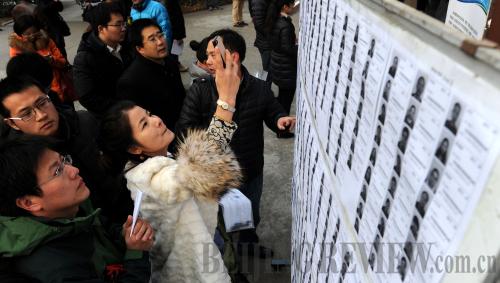|
 |
|
FIERCE COMPETITION: Candidates wait to sit the National Graduate Admission Exam at a University in Hefei, Anhui Province, on January 4. This year saw 1.72 million enroll for the exam, a decline of 40,000 from the previous year and the first drop in five years (LIU JUNXI) |
Air Pollution
In the country's latest effort to combat pollution, the 31 provincial-level regions of the Chinese mainland have been set targets to reduce major air pollutants by 5 to 25 percent.
Among provincial-level regions, 11 were given goals for reducing PM2.5, including an annual 25-percent decrease, the highest, for Beijing, the neighboring Tianjin Municipality and Hebei Province, according to a liability paper signed on January 7 by the regions and the Ministry of Environmental Protection.
PM2.5 refers to airborne particles less than 2.5 microns in diameter, making them small enough to pass into the gas exchange region of the lungs.
The paper also urged the regions to take measures such as reducing coal consumption, eliminating outdated industrial capacity and tightened management and control of heating boilers, vehicles and dust.
Local governments have been ordered to map out detailed plans to ensure the implementation of various anti-pollution methods and lay down specific goals for each year.
Meanwhile, the State Council, China's Cabinet, is planning a system of evaluation for each provincial-level government's progress, with those failing to reach their goals to be named and shamed.
A government report released in December 2013 revealed that progress in China's four environmental targets was lagging, including carbon dioxide emissions and energy consumption. In the relatively more polluted north China, 58 days of heavy air pollution were reported last year, roughly one out of every six.
Protecting Minors
Prosecutors should not publicly disclose the private information of minors involved in criminal cases, and are required to respect and protect their reputations, China's top procuratorate said on January 7.
Under a revised regulation issued by the Supreme People's Procuratorate on December 31, 2013, names, residences and photos of minors implicated in criminal cases, as well as other information implying their identity, should not be made public. Juveniles' reputations should be protected and their personal dignity should be respected, the document said.
The regulation also instructed procuratorates at provincial and city levels to set special tribunals or panels to deal with juvenile cases. It recommended that prosecutors in charge of such cases receive special criminological, sociological and psychological training, as well as training on the physical and mental traits of young people.
Medical Waste
China will impose harsh punishments on those who handle medical waste improperly, in a bid to reduce pollution and protect public health.
Companies or government agencies that illegally collect, store, transport and handle medical waste will have their licenses revoked and will be heavily fined, according to a statement from the National Health and Family Planning Commission issued on January 8.
The commission said that it will strengthen the monitoring of medical waste disposal companies and units, as well as cooperating with environmental authorities to shut down substandard waste disposal facilities.
It also urged local authorities to establish a sound pricing system for medical waste procurement before the end of 2015 and improve hazard-free disposal of medical waste.
Tibetan Encyclopedia
Translation has begun on a Tibetan version of the Chinese Encyclopedia, making this the third ethnic minority language edition of the comprehensive encyclopedia.
The translation is estimated to be completed in five years, according to a statement by Cedain Zhaxi, head of the Tibetology Studies Institute of the University of Tibet, made on January 6.
Translation and publication of the Tibetan version will be carried out jointly by the university and the Tibet Autonomous Region's press and publication authorities.
The Tibetan edition of the Chinese Encyclopedia will significantly enrich the Tibetan language, according to Cedain Zhaxi, who is in charge of the translation project. He said that hundreds of Chinese terms in philosophy, foreign literature and world geography have no corresponding Tibetan expressions.
Cedain Zhaxi said the Tibetan version would be distributed among schools and libraries in cities, monasteries and rural areas.
Published in 2009, the second edition of the Chinese Encyclopedia consists of 32 volumes and 60,000 items. In 2011, China started translating the encyclopedia into the Uygur and Kazakh languages.
| 